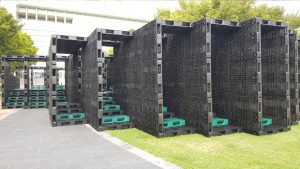For this looking outwards, I liked the project that Romi Jin covered in her looking outwards 3 about computational fabrication. As an architecture major, computational design is one of the many ways we can design buildings for the future. The specific computational project was HG’s opening chronometry. I agree with the fact that using a tool called Grasshopper to create parametric designs are a very easy way to create iterations in your design process, versus trying to record all those things by hand. My favorite project by this group is their Hide-and-Seek project, which is an art museum and cultural space. They used computational design to create a labyrinth of corridors that visitors can use to go through series of small spaces. Users are to “hide and discover each other” through different material transparencies and stairs. The main building material is recycled plastic pallets & LED lights for lighting, which is an unusual combination of materials I haven’t seen before.
Click here for a link to the original looking outwards post, and click here for the link to the project!

![[OLD FALL 2018] 15-104 • Introduction to Computing for Creative Practice](https://courses.ideate.cmu.edu/15-104/f2018/wp-content/uploads/2020/08/stop-banner.png)